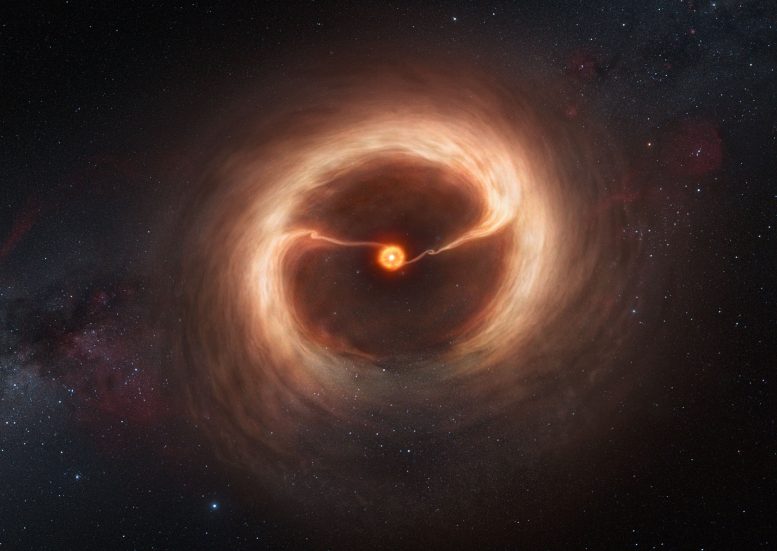
This artist’s impression shows the disc of gas and cosmic dust around the young star HD 142527. Astronomers using the Atacama Large Millimeter/submillimeter Array (ALMA) telescope have seen vast streams of gas flowing across the gap in the disc. These are the first direct observations of these streams, which are expected to be created by giant planets guzzling gas as they grow, and which are a key stage in the birth of giant planets. Credit: ALMA (ESO/NAOJ/NRAO)/M. Kornmesser (ESO)/Nick Risinger
Using the ALMA telescope, scientists have made the first direct observations of the streams of gas that flow across a gap in the disc of gas and cosmic dust that surrounds a young star, discovering diffuse gas remaining in the gap and two denser streams of gas flowing from the outer disc, which is possibly hiding the formation of giant planet within.
Astronomers using the Atacama Large Millimeter/submillimeter Array (ALMA) telescope have seen a key stage in the birth of giant planets for the first time. Vast streams of gas are flowing across a gap in the disc of material around a young star. These are the first direct observations of such streams, which are expected to be created by giant planets guzzling gas as they grow. The result is published on January 2, 2013, in the journal Nature.
The international team of astronomers studied the young star HD 142527, over 450 light-years from Earth, which is surrounded by a disc of gas and cosmic dust — the remains of the cloud from which the star formed. The dusty disc is divided into an inner and an outer part by a gap, which is thought to have been carved by newly forming gas giant planets clearing out their orbits as they circle the star. The inner disc reaches from the star out to the equivalent of the orbit of Saturn in the Solar System, while the outer disc begins about 14 times further out. The outer disc does not surround the star uniformly; instead, it has a horseshoe shape, probably caused by the gravitational effect of the orbiting giant planets.
According to theory, the giant planets grow by capturing gas from the outer disc, in streams that form bridges across the gap in the disc.
“Astronomers have been predicting that these streams must exist, but this is the first time we’ve been able to see them directly,” says Simon Casassus (Universidad de Chile, Chile), who led the new study. “Thanks to the new ALMA telescope, we’ve been able to get direct observations to illuminate current theories of how planets are formed!”
Casassus and his team used ALMA to look at the gas and cosmic dust around the star, seeing finer details, and closer to the star, than could be seen with previous such telescopes. ALMA’s observations, at submillimeter wavelengths, are also impervious to the glare from the star that affects infrared or visible-light telescopes. The gap in the dusty disc was already known, but they also discovered diffuse gas remaining in the gap, and two denser streams of gas flowing from the outer disc, across the gap, to the inner disc.
“We think that there is a giant planet hidden within, and causing, each of these streams. The planets grow by capturing some of the gas from the outer disc, but they are really messy eaters: the rest of it overshoots and feeds into the inner disc around the star” says Sebastián Pérez, a member of the team, who is also at Universidad de Chile.
The observations answer another question about the disc around HD 142527. As the central star is still forming, by capturing material from the inner disc, the inner disc would have already been devoured, if it was not somehow topped up. The team found that the rate at which leftover gas streams onto the inner disc is just right to keep the inner disc replenished, and to feed the growing star.
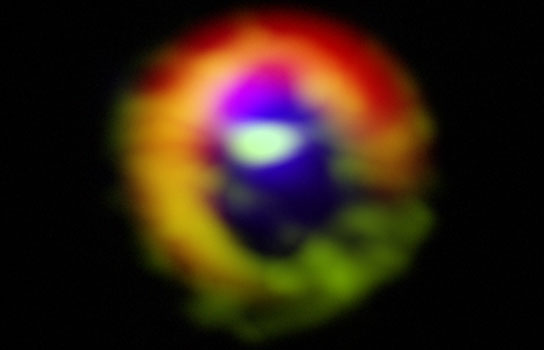
Observations made with the Atacama Large Millimeter/submillimeter Array (ALMA) telescope of the disc of gas and cosmic dust around the young star HD 142527, showing vast streams of gas flowing across the gap in the disc. These are the first direct observations of these streams, which are expected to be created by giant planets guzzling gas as they grow, and which are a key stage in the birth of giant planets.
The dust in the outer disc is shown in red. Dense gas in the streams flowing across the gap, as well as in the outer disc, is shown in green. Diffuse gas in the central gap is shown in blue. The gas filaments can be seen at the three o’clock and ten o’clock positions, flowing from the outer disc towards the center. The dense gas observed is HCO+, and the diffuse gas is CO. The outer disk is roughly two light-days across. If this were our own Solar System, the Voyager 1 probe — the most distant manmade object from Earth — would be at approximately the inner edge of the outer disk. Credit: ALMA (ESO/NAOJ/NRAO), S. Casassus et al.
Another first is the detection of the diffuse gas in the gap. “Astronomers have been looking for this gas for a long time, but so far we only had indirect evidence for it. Now, with ALMA, we can see it directly,” explains Gerrit van der Plas, another team member at Universidad de Chile.
This residual gas is more evidence that the streams are caused by giant planets, rather than even larger objects such as a companion star. “A second star would have cleared out the gap more, leaving no residual gas. By studying the amount of gas left, we may be able to pin down the masses of the objects doing the clearing,” adds Pérez.
What about the planets themselves? Casassus explains that, although the team did not detect them directly, he is not surprised. “We searched for the planets themselves with state-of-the-art infrared instruments on other telescopes. However, we expect that these forming planets are still deeply embedded in the streams of gas, which are almost opaque. Therefore, there may be little chance of spotting the planets directly.”
Nevertheless, the astronomers aim to find out more about the suspected planets by studying the gas streams as well as the diffuse gas. The ALMA telescope is still under construction and has not yet reached its full capabilities. When it is complete, its vision will be even sharper, and new observations of the streams may allow the team to determine the properties of the planets, including their masses.
This video starts with a broad panorama of the spectacular central regions of the Milky Way seen in visible light. It then zooms in to the young star HD 142527. Credit: ALMA (ESO/NAOJ/NRAO)/Nick Risinger (skysurvey.org) Music: movetwo
Reference: “Flows of gas through a protoplanetary gap” by Simon Casassus, Gerrit van der Plas, Sebastian Perez M, William R. F. Dent, Ed Fomalont, Janis Hagelberg, Antonio Hales, Andrés Jordán, Dimitri Mawet, Francois Ménard, Al Wootten, David Wilner, A. Meredith Hughes, Matthias R. Schreiber, Julien H. Girard, Barbara Ercolano, Hector Canovas, Pablo E. Román and Vachail Salinas, 2 January 2013, Nature.
DOI: 10.1038/nature11769
The team is composed of S. Casassus (Universidad de Chile, Chile; Millennium Nucleus for Protoplanetary Disks — Ministry of Economy, Chilean Government), G. van der Plas (Universidad de Chile, Chile), S. Pérez M. (Universidad de Chile, Chile), W. R. F. Dent (Joint ALMA Observatory, Chile; European Southern Observatory, Chile), E. Fomalont (NRAO, USA), J. Hagelberg (Observatoire de Genève, Switzerland), A. Hales (Joint ALMA Observatory, Chile; NRAO, USA), A. Jordán (Pontificia Universidad Católica de Chile, Chile), D. Mawet (European Southern Observatory, Chile), F. Ménard (CNRS / INSU, France; Universidad de Chile, Chile; CNRS / UJF Grenoble, France), A. Wootten (NRAO, USA), D. Wilner (Harvard-Smithsonian Center for Astrophysics, USA), A. M. Hughes (U. C. Berkeley, USA), M. R. Schreiber (Universidad Valparaiso, Chile), J. H. Girard (European Southern Observatory, Chile), B. Ercolano (Ludwig-Maximillians-Universität, Germany), H. Canovas (Universidad Valparaiso, Chile), P. E. Román (University of Chile, Chile), V, Salinas (Universidad de Chile, Chile).


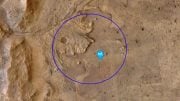


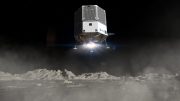
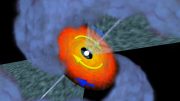


The inner rotation and outer momentum theory of acceleration decides the number of rejections disc of gas and cosmic dust says Sankaravelayudhan Nandakumar
Spinning star ejecting number of jets for planetary condensation based on energy availability follow a Faradays law of a generator
The international team of astronomers studied the young star HD 142527, over 450 light-years from Earth, which is surrounded by a disc of gas and cosmic dust — the remains of the cloud from which the star formed. The dusty disc is divided into an inner and an outer part by a gap, which is thought to have been carved by newly forming gas giant planets clearing out their orbits as they circle the star. The inner disc reaches from the star out to the equivalent of the orbit of Saturn in the Solar System, while the outer disc begins about 14 times further out. The outer disc does not surround the star uniformly; instead, it has a horseshoe shape, probably caused by the gravitational effect of the orbiting giant planets.
Two aspects of light, known as orbital angular momentum and circular polarization (or spin angular momentum of star boundary decides the ejection cones may be applied on plentray nascent formation for a condensation at a distance.. Polarization is direction along which light vibrates. In circularly polarized light, the vibration of light traces a circle. Think about orbital angular momentum and circular polarization like the motion of a planet. Circular polarization is the direction in which a star rotates on its axis while orbital momentum describes how the planet are formed. the electrons were decoupled from the light pulse at a particular moment in time, using a separator foil that is opaque for the laser light but can transmit fast plasma ejections of electrons also at the point of 120 degree phase and the number of ejections depends upto the spin rate of star electrons Electric dipole moment (EDM). The method involves trapping molecular ions forming a jet. in spinning electric and magnetic fields. Researchers measure changes over time in the “spin” direction of the molecules’ unpaired electrons (arrows in yellow spheres), which act like tiny bar magnets. Specific patterns in the rate of change, reflecting alterations in the gap between two magnetic energy levels in the molecules, would indicate the existence and size of an EDM.